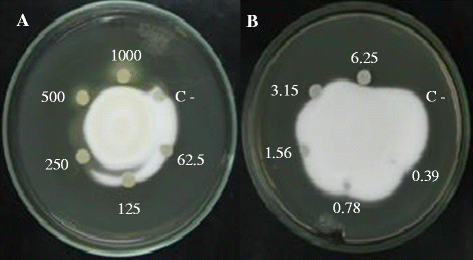Antifungal activity of pomegranate peel extract and isolated compound punicalagin against dermatophytes
- PMID: 25260038
- PMCID: PMC4353666
- DOI: 10.1186/s12941-014-0032-6
Antifungal activity of pomegranate peel extract and isolated compound punicalagin against dermatophytes
Abstract
Background: Dermatophyte species infect the epidermis and appendages, often with serious social and health-economic consequences. The hydroalcoholic extract of pomegranate fruit peel showed activity against the dermatophyte fungi Trichophyton mentagrophytes, T. rubrum, Microsporum canis and M. gypseum.
Methods: Hydroalcoholic extract was prepared with pomegranate peels. This crude extract was fractionated and submitted to liquid-liquid partition, resulting in an active fraction which was fractionated in a Sephadex LH-20 column, followed by a Lobar column. The structure of the active compound was established with the use of spectroscopic methods.
Results: The crude extract of pomegranate fruit peel showed activity against the dermatophytes Trichophyton mentagrophytes, T. rubrum, Microsporum canis, and M. gypseum, with MICs values of 125 μg/ml and 250 μg/ml, respectively for each genus. Punicalagin was isolated and identified by spectroscopic analysis. The crude extract and punicalagin showed activity against the conidial and hyphal stages of the fungi. The cytotoxicity assay showed selectivity for fungal cells than for mammalian cells.
Conclusions: These results indicated that the crude extract and punicalagin had a greater antifungal activity against T. rubrum, indicating that the pomegranate is a good target for study to obtain a new antidermatophyte medicine.
Figures


Similar articles
-
In vitro antifungal activity of extracts and neolignans from Piper regnellii against dermatophytes.J Ethnopharmacol. 2008 May 8;117(2):270-7. doi: 10.1016/j.jep.2008.01.039. Epub 2008 Feb 16. J Ethnopharmacol. 2008. PMID: 18394835
-
Antifungal activity of Ocimum gratissimum towards dermatophytes.Mycoses. 2005 May;48(3):172-5. doi: 10.1111/j.1439-0507.2005.01100.x. Mycoses. 2005. PMID: 15842332
-
Antifungal activity of Aegle marmelos (L.) Correa (Rutaceae) leaf extract on dermatophytes.Asian Pac J Trop Biomed. 2011 Aug;1(4):309-12. doi: 10.1016/S2221-1691(11)60049-X. Asian Pac J Trop Biomed. 2011. PMID: 23569781 Free PMC article.
-
How to: perform antifungal susceptibility testing of microconidia-forming dermatophytes following the new reference EUCAST method E.Def 11.0, exemplified by Trichophyton.Clin Microbiol Infect. 2021 Jan;27(1):55-60. doi: 10.1016/j.cmi.2020.08.042. Epub 2020 Sep 8. Clin Microbiol Infect. 2021. PMID: 32916260 Review.
-
Antifungal activity of lichen compounds against dermatophytes: a review.J Appl Microbiol. 2019 Aug;127(2):308-325. doi: 10.1111/jam.14209. Epub 2019 May 8. J Appl Microbiol. 2019. PMID: 30664814 Review.
Cited by
-
Beneficial effect of Punica granatum peel extract on murine malaria-induced spleen injury.BMC Complement Altern Med. 2016 Jul 16;16:221. doi: 10.1186/s12906-016-1207-9. BMC Complement Altern Med. 2016. PMID: 27422638 Free PMC article.
-
Exploring Phenolic Compounds in Crop By-Products for Cosmetic Efficacy.Int J Mol Sci. 2024 May 28;25(11):5884. doi: 10.3390/ijms25115884. Int J Mol Sci. 2024. PMID: 38892070 Free PMC article. Review.
-
Carboxymethyl cellulose/shellac composite loaded with pomegranate extract and jojoba oil as anti-mycotic and anti-mycotoxigenic food packaging materials.Sci Rep. 2025 Jan 6;15(1):955. doi: 10.1038/s41598-024-81933-7. Sci Rep. 2025. PMID: 39762269 Free PMC article.
-
Anti-saprolegnia potency of some plant extracts against Saprolegnia diclina, the causative agent of saprolengiasis.Saudi J Biol Sci. 2020 Jun;27(6):1482-1487. doi: 10.1016/j.sjbs.2020.04.008. Epub 2020 Apr 13. Saudi J Biol Sci. 2020. PMID: 32489284 Free PMC article.
-
Phytochemical Analysis and Therapeutic Potential of Tuberaria lignosa (Sweet) Samp. Aqueous Extract in Skin Injuries.Plants (Basel). 2025 Jul 25;14(15):2299. doi: 10.3390/plants14152299. Plants (Basel). 2025. PMID: 40805647 Free PMC article.
References
-
- Johnson L. Dermatophytes- the skin eaters. Mycologist. 2003;17:147–149. doi: 10.1017/S0269915X04004185. - DOI
Publication types
MeSH terms
Substances
LinkOut - more resources
Full Text Sources
Other Literature Sources

